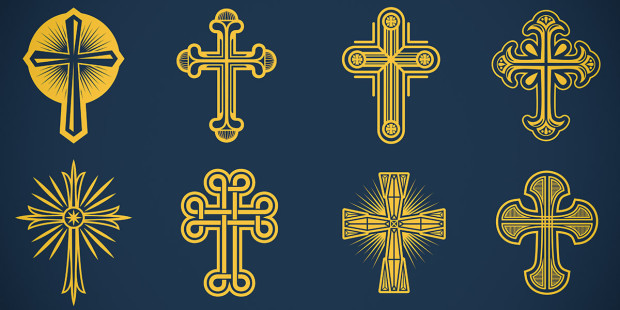Not all crosses are the same, and each has its own meaning
The cross is a common emblem for many cultures and religions. But his most important representation is for Christianity, since Jesus Christ died on the cross.
As a universal symbol of the Christian, it has its variations, according to historical facts and different cultures and Christian communities.
1. Latin Cross
Also called “crux ordinaria” in Latin, it is the one that represents the Crucifixion of Jesus Christ. It is the symbol most used by the different confessions of Christianity and, alongside the Greek cross, is the most common form.

2. Anchored cross
It is a cross that ends in the form of an anchor. The anchored cross is also known as the Cross of St. Clement, in reference to the manner in which the saint was martyred, by order of the emperor Trajan. He ordered the saint to be thrown into the sea with an iron anchor. The anchor symbolizes to the Christian a new beginning or hope in eternal life.

3. Greek cross
The Greek cross, or “crux immissa quadrata”, is a cross formed by four arms of equal measure. It was the cross of primitive Christianity until the Renaissance, when the Latin cross began to be used in Rome. They are still widely used in Eastern Europe and part of the Orthodox Church.
4. St. Peter’s cross
It is the inverted Latin cross, associated with the martyrdom of the Apostle Peter, who, by humility, did not want to die in the same way as Jesus, and asked them to reverse their cross. Nowadays, some people have misrepresented their meaning and have taken this cross as a symbol of Satanism.

5. Chi Chi Cross
It is the inverted Latin cross, associated with the martyrdom of the Apostle Peter, who, by humility, did not want to die in the same way as Jesus, and asked them to reverse their cross. Nowadays, some people have misrepresented their meaning and have taken this cross as a symbol of Satanism.

6. Coptic cross
It is the cross most used by the Coptic Church of Alexandria and the Coptic Catholic Church. Very similar to a Greek cross, but with abundant decoration.

7. Armenian cross or jachkar
Also known as a flowery cross, at each end there is a clover, symbol of the Trinity. It is very popular in Armenia, where it is common to see the famous stone or jachkar crosses.

8. Marian cross
This cross was designed for the papal shield of John Paul II and represents his great devotion to Our Lady.

9. Papal cross
This cross is also called the pontifical cross. It has three arms of different sizes, which represent the three roles of the Pope: bishop of Rome, patriarch of the West and successor of St. Peter.

10. Baptismal cross
The baptismal cross is the Greek cross attached to the X, the first letter of the word Christ. This cross symbolizes regeneration. And Baptism is the regeneration to the new life in Christ.

11. Cruz Tau
It is also called the cross of Saint Anthony or commissa. It has the form of the letter T, which is the last letter of the Hebrew alphabet. St. Francis of Assisi used it as a symbol for his Order.

12. Cross of Jerusalem
It is composed of five Greek crosses, one large and four smaller ones within their angles. They are said to symbolize the five wounds of Christ, or even Jesus and the four Gospels.

13. Malta Cross
The cross of Malta is also called the Cross of St. John. It has the shape of the Greek cross, but with the arrow-shaped arms pointing towards the center. It is the symbol of the knights who served in the hospital of Jerusalem and later like Knights of Saint John (the Sovereign Order of Malta, the first Military Order arisen at the time of the Crusades).

14. St. George Cross
The cross of St. George is red. It is very used in heraldry and is currently part of several flags.

15. Cross of Santiago
This is the cross that distinguished the knights of the Order of Santiago de Compostela. It is red, in the shape of the Latin cross, but with the tips simulating a sword, in the shape of a fleur-de-lis. It is often accompanied by the shell, symbol of the pilgrim.

16. Cross of Saint Andrew
It is the Greek cross rotated in the form of X, associated with the apostle Saint Andrew, who was martyred on a cross of this form, in Patras (Greece). The apostle suffered for three days on this cross, during which time he continued to preach.

17. Celtic Cross
Cruz com um anel circular, muito ornamentada. Na Escócia e na Irlanda, enormes cruzes como esta adornam as paisagens. São associadas à evangelização dessas terras.

18. Byzantine Cross
Cross with three arms, where the superior is called “crucis”, the inferior one positions of oblique form and alludes to the “suppedaneum” (wood that supported the feet of Jesus Christ crucified). It has become a symbol of the Russian Orthodox Church.

